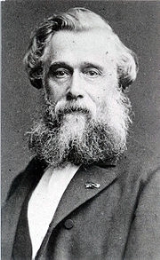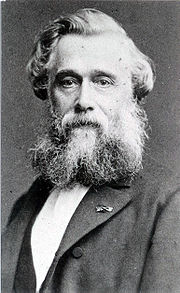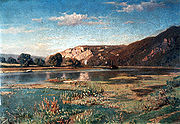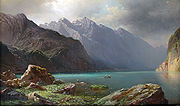
François Roffiaen
Encyclopedia

Ypres
Ypres is a Belgian municipality located in the Flemish province of West Flanders. The municipality comprises the city of Ypres and the villages of Boezinge, Brielen, Dikkebus, Elverdinge, Hollebeke, Sint-Jan, Vlamertinge, Voormezele, Zillebeke, and Zuidschote...
, West Flanders – 20 January 1898, Ixelles) was a Belgian landscape painter who specialised in painting Alpine landscapes.
Biography
In Ypres, the members of the family on his father’s side came from modest origins. The men were day labourers, builders, innkeepers or saddlers and the women were dressmakers or lace makers. Jean Francois, his father (1794–1837) was an upholsterer and his mother, Victoire Félicité (1789–1870), was the daughter of a tradesman from Aire-sur-la Lys (France).His first marriage took place in Ixelles on 19 November 1847 to Éléonore Bodson from Dinant (1792–1854) and on 14 October 1858 in Louvain he later married Marie Anne Tilly, who bore him a son named Hector (1859–1895). He lived in the Belgian capital from 1847, changing his address several times, from rue aux Herbes Potagères 30 to Saint-Josse-ten-Noode up to 1848, rue Goffart 28 in Ixelles until 1853, chaussée de Wavre 31, also in Ixelles until 1859, chaussée de Charleroi 131 in Saint-Gilles until 1863 and finally rue du Financier, which was renamed a little later to rue Godecharle 16 in Ixelles.
François Roffiaen was barely three years old, when for unknown reasons he went to live with his paternal uncle, Joseph-Louis-Augustin, who was a bookseller in the rue de l’Ange in Namur, the city where he spent, as he himself noted « the most beautiful years of his existence » and where he frequented the Atheneum, as well as the Academy of Painting (1835–1839) under the direction of Ferninand Marinus (1808–1890). Among his fellow students were Louis Bonet (1822–1894), Jean Baptiste Kindermans (1821–1876) and Joseph Quinaux (1822–1895).
He followed his artistic studies at the Academy of Brussels (1839–1842), notably under the famous vedutiste, François Bossuet (1789–1889) who was responsible for teaching him perspective and who was the authority on landscapes and city views. Then he attended the Brussels studio of Pierre-Louis Kühnen (1812–1877), a painter originating from Aix-la-Chapelle, specialised in painting romantic landscapes. Roffiaen received for that reason an annual subsidy of 600 francs, paid by the city of Ypres (1841–1845 or 1846). At the same time, he taught drawing at the college of Dinant. To thank the city of his birth for the support they had given him, he gave a Landscape with Hydraulic Mill (1844), a Waterfall of the Aar in the High Alps and a View from Grütli on Lake Geneva (1857) to the local museum. He also bequeathed a lot later a large Valley of Chamonix to the commune of Ixelles, of which he was on the board of directors since the time of its creation in 1892.
These titles clearly reveal one of the artist’s favourite themes, the representation of Alpine landscapes. Deeply impressed by the canvases Alexandre Calame (1810 - 1864) had sent to Belgian Salons, François Roffiaen indeed won a place at Geneva in the autumn of 1846 and stayed for six months beside this master, before discovering the mountains himself. He continued to familiarise himself with the landscapes of Switzerland, Austria, Upper Bavaria and the Haute-Savoie during several other journeys (1852, 1855, 1856, 1864, 1868, 1879). But the painter also liked to represent picturesque scenes of the valleys of the Meuse and the Ourthe, the Scottish lochs, discovered in 1862, or the extensive heather of Limbourg, which he travelled through from the middle of the preceding decade, so that like Edmond Tschaggeny (1818–1873), he became one of the pioneers of the Campine Painters, a school which has been unjustly forgotten
Since the beginning of the year 1840, Roffiaen adopted the path followed by all artists, anxious to assure the greatest possible publicity for their works : participation in big group exhibitions. That is how for more than fifty years his paintings came to be hanging on the picture rails of the three yearly Salons of Antwerp, Brussels and Gent and were included in very many exhibitions in the provinces (Bruges, Dendermonde, Kortrijk, Leuven, Liège, Mechelen, Mons, Namur, Spa, Ostend, Ypres) and abroad (Alger, Amsterdam, Barcelona, Bremen, Caracas, Dublin, Le Havre, London, Lyon, Melbourne, Munich, Nice, Paris, Reims, Rotterdam, The Hague).
The years 1850–1860 were those of his greatest success, including numerous sales in Belgium, in Great Britain and in the United States, having works acquired by the Shah of Persia, by the Belgian and British royal houses, a study tour of Scotland commissioned by Queen Victoria, but which unfortunately never took place because of the sudden death of Albert, Prince Consort (December 1861), and when he received the title of Chevalier de l’Ordre de Léopold (1869).
His painting, constructed according to indefinitely repeated formulae and each year becoming a little more tired, finished however by wearying the art chroniclers : « Critics of the press have often reproached him for the bias he shows in his painting. M Roffiaen has ignored them, he has continued to accumulate landscapes of Belgium, Scotland, Switzerland, Germany, Italy, what do I know, combing them without rest, using the same formula, making do with the same sky, the same trees, the same rocks, unconcerned by the latitudes, according to the taste of a special public, who buy all of that and pay him handsomely. Leave M. Roffiaen alone, gentlemen of the press, he paints his little nature scenes one demands of him and knows well the reason why. » (G. H., L’Organe de Namur et de la Province, 1874).

Johannes Hubertus Leonardus de Haas
Johannes Hubertus Leonardus de Haas was a Dutch animal and landscape painter, and a peripheral figure of the Hague School....
(1832-1908), Adolf Dillens (1821–1877), Théodore Gérard (1829–1902), Louis Robbe (1806–1887), Paul Van der Vin (1823–1877), François Van Leemputten (1850–1914), Eugène Verboeckhoven (1799–1881) or again the brothers Edward (1819–1897) and Constant (1823–1867) Woutermaetens.
Initiated in April 1854 into the most important lodge in the kingdom, The True Friends of the Union and of Progress Reunited, François Roffiaen pushed his masonic career up to the 33rd and last degree of the Ancient and Accepted Scottish Rite, his name appearing in the List of Great General Inspectors for the Supreme Council of Belgium, of which he was Grand Master of Ceremonies for twenty eight years. In 1883, his involvement encouraged him to pay homage openly by dedicating one of his paintings to his Brother, General Antonio Guzmán-Blanco (1829–1899), president of the republic of Venezuela.

Some months after his death, the local authorities gave the name of François Roffiaen to a street in Ixelles. In 1907, an article was dedicated to him in the Biographie nationale, edited by the Royal Academy of Belgium. Madeleine Ley (1901–1981), his great grand daughter (Prix Rossel 1940), called his image briefly to mind in her novel Olivia (Gallimard, 1936 ; re-edition Labor, 1986). But the character had already been forgotten. In the first half of the twentieth century his name was no longer cited except by chance, his case dismissed in a few hasty phrases and often scathingly, preferring a livlier form of art, one that was more personal, more « sincere », more « credible », in a word, more « modern » than his, as if this was understood once and for all. Since the years 1960–70, however, there has been a renewal of interest in the art of the « little masters » of the nineteenth century, to which there are more than one « folding away seat of some kind after the official armchair that many among them have occupied at the time of a triumphant academism and towards which certain people attempt to return, since the course of taste is in perpetual motion » (Gérald Schurr, 1979), and the work of Roffiaen is on the way to becoming rehabilitated. A first exhibition was especially dedicated to him at the communal Museum of Ypres, from 5 December 1998 to 4 April 1999.

